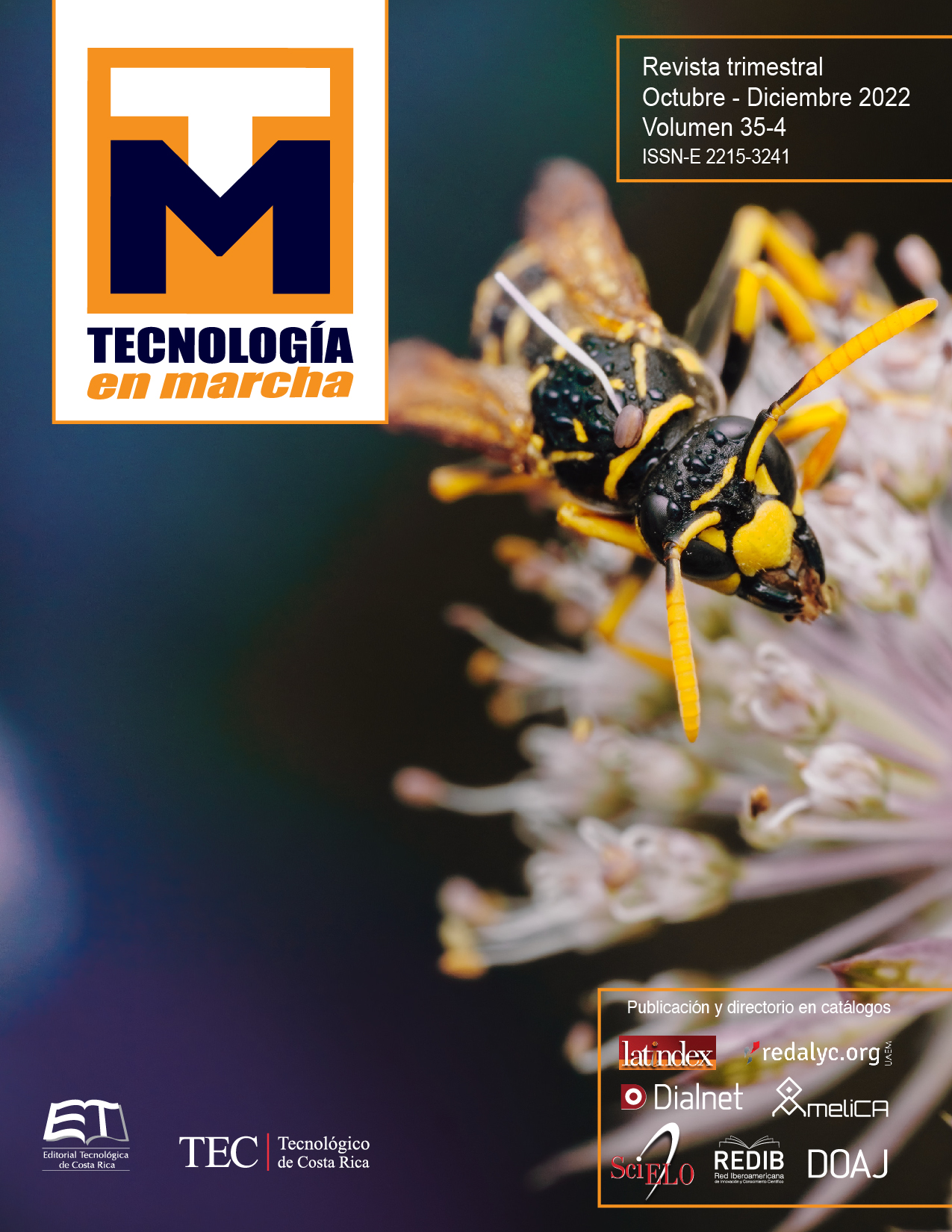Vehicle traffic flow forecasting Costa Rica highway 27
Main Article Content
Abstract
Forecasting vehicle traffic flow is considered an important input for traffic planning and management for the countries’ intelligent transport systems (ITS). This article analyzes the hourly flow of light vehicle traffic that drives in highway 27 of Costa Rica in one direction (San Jose-Caldera). The data collected by the ITS of the route is used to forecast the behavior of hourly vehicular traffic. For this, three forecasting methods are proposed, which are compared to select the model with best performance: Seasonal Arima (SARIMA), Seasonal Naïve (SNAIVE), and Autoregression with Neural Network (NNAR). All three models are evaluated and are considered useful for prediction, however the NNAR model results in better performance when forecasting the hourly time series with the lowest MAPE of 9.4 and is consider a candidate for use in ITS. By applying the cross-validation process in the models, the conclusion is supported that as the NNAR is tested for more days, the prediction results are more stable and accurate.
Article Details

This work is licensed under a Creative Commons Attribution-NonCommercial-NoDerivatives 4.0 International License.
Los autores conservan los derechos de autor y ceden a la revista el derecho de la primera publicación y pueda editarlo, reproducirlo, distribuirlo, exhibirlo y comunicarlo en el país y en el extranjero mediante medios impresos y electrónicos. Asimismo, asumen el compromiso sobre cualquier litigio o reclamación relacionada con derechos de propiedad intelectual, exonerando de responsabilidad a la Editorial Tecnológica de Costa Rica. Además, se establece que los autores pueden realizar otros acuerdos contractuales independientes y adicionales para la distribución no exclusiva de la versión del artículo publicado en esta revista (p. ej., incluirlo en un repositorio institucional o publicarlo en un libro) siempre que indiquen claramente que el trabajo se publicó por primera vez en esta revista.
References
Programa Estado de la Nación, “Estado de la Nación en Desarrollo Humano Sostenible”, Transporte y Movilidad: retos en favor del desarrollo humano, Estado de la Nación, Pavas, San José,2018.
D.Arguedas.“Transporte Ineficiente entraba esfuerzo tico para combatir cambio climático”, Ojo al Clima.com.https://ojoalclima.com/transporte-ineficiente-entraba-esfuerzo-tico-para-combatir-cambio-climatico/ (accesado Mar,2019).
I.Laña et al. “Road traffic forecasting: Recent advances and new challenges”,IEEE Intelligent transportation systems, 2018. https://ieeexplore.ieee.org/document/8344781.
M.Zahid et al. “Freeway short-term travel speed prediction based on data collection time-horizons: A fast forest quantile regression approach”, Approach.Sustainability, Vol.12,2020.https://www.mdpi.com/2071-1050/12/2/646.
M.Annunziato et al. “Urban traffic flow forecasting using neural-statistic hybrid modeling”, Advances in Intelligent Systems and Computing,188:183-190,2013.https://link.springer.com/chapter/10.1007/978-3-642-32922-7_19.
T.Ma et al. “Nonlinear multivariate time–space threshold vector error correction model for short term traffic state prediction,” Transportation Research Part B: Methodological, 76,27-47,2015.https://www.sciencedirect.com/journal/transportation-research-part-b-methodological.
Y.Zhang y Y.Zhang. “A comparative study of three multivariate short-term freeway traffic flow forecasting methods with missing data”, Journal of Intelligent Transportation Systems,20(3),205-218,2016. https://www.tandfonline.com/doi/abs/10.1080/15472450.2016.1147813
Y.Lv et al. “Traffic flow prediction with big data: a deep learning approach” approach”, IEEE Transactions on Intelligent Transportation Systems, 16(2), 865-873,2014. https://ieeexplore.ieee.org/document/6894591.
B.Sharma et al. “ANN based short-term traffic flow forecasting in undivided two lane highway”, Journal of Big Data, 5(1), 1-16.2018. https://journalofbigdata.springeropen.com/articles/10.1186/s40537-018-0157-0.
R.Hyndman et al. “Forecasting: principles and practice”, OTexts,2018. https://otexts.com/fpp2/.
S.Kumar y L.Vanajakshi. “Short-term traffic flow prediction using seasonal ARIMA model with limited input data”, European Transport Research Review, 7(3), 1-9.2015. https://etrr.springeropen.com/articles/10.1007/s12544-015-0170-8.
Y.Cong et al.“Traffic flow forecasting by a least squares support vector machine with a fruit fly optimization algorithm”, European Transport Research Review, 7(3), 1-9,2016.https://www.sciencedirect.com/science/article/pii/S1877705816002472.
A.Emargun y D.Levinson. “ Spatiotemporal traffic forecasting: review and proposed directions”, Transport Reviews, Vol.38:6, 786-814 ,2018. https://www.researchgate.net/publication/323584206_Spatiotemporal_traffic_forecasting_review_and_proposed_directions.
X.Luo et al.“Spatiotemporal traffic flow prediction with KNN and LSTM”, LSTM. Journal of Advanced Transportation, 2019 https://www.researchgate.net/publication/331390762_Spatiotemporal_traffic_flow_prediction_with_KNN_and_LSTM.
L.Do et al. “Survey of neural network‐based models for short‐term traffic state prediction”, Wiley Interdisciplinary Reviews: Data Mining and Knowledge Discovery, 9(1), e1285.,2019. https://wires.onlinelibrary.wiley.com/doi/abs/10.1002/widm.1285.
X.Li and W. Gao.(2015). “Prediction of traffic flow combination model based on data mining”.International Journal of Database Theory and Application, 8(6), 303 -312,2015.https://www.researchgate.net/publication/299422405_Prediction_of_Traffic_Flow_Combination_Model_Based_on_Data_Mining.
E.Vlahogianni, et al. “Short-term traffic forecasting: Where we are and where we’re going”, Transportation Research Part C: Emerging Technologies, 43, 3-19,2015. https://www.sciencedirect.com/science/article/abs/pii/S0968090X14000096.
R.Hyndman. “A forecast ensemble benchmark”, Forecasting: principles and practice. OTexts,2018.https://robjhyndman.com/hyndsight/benchmark-combination.
G.Cordero. “Sistemas de transporte inteligente-conduciendo hacia futuro Centroamérica”.Lanner.com. https://www.lanner-america.com/es/blog-es/los-sistemas-de-transporte-inteligentes-y-el-futuro-sostenible-del-transporte/ (accesado Jun,2020).
R.L.McLaughlin. “Forecasting models: Sophisticated or naive?”, Journal of Forecasting,2(3),274,1983.https://www.researchgate.net/publication/326972994_A_Naive_Approach_for_Comparing_a_Forecast_Model.
R.Thoplan. “Simple v/s Sophisticated Methods of Forecasting for Mauritius Monthly Tourist Arrival Data”, International Journal of Statistics and Applications,4,217-223,2014. https://www.researchgate.net/publication/265731871_Simple_vs_Sophisticated_Methods_of_Forecasting_for_Mauritius_Monthly_Tourist_Arrival_Data.

